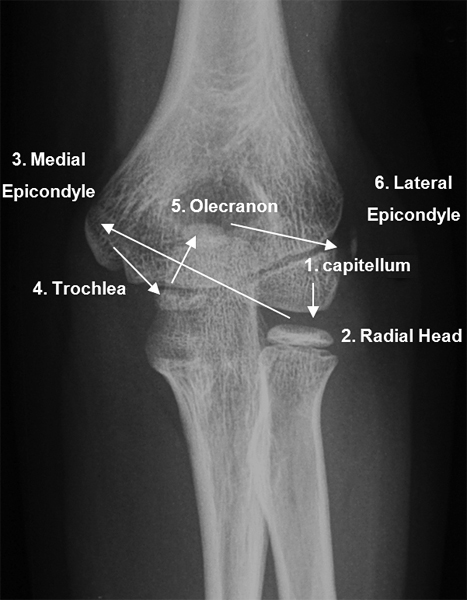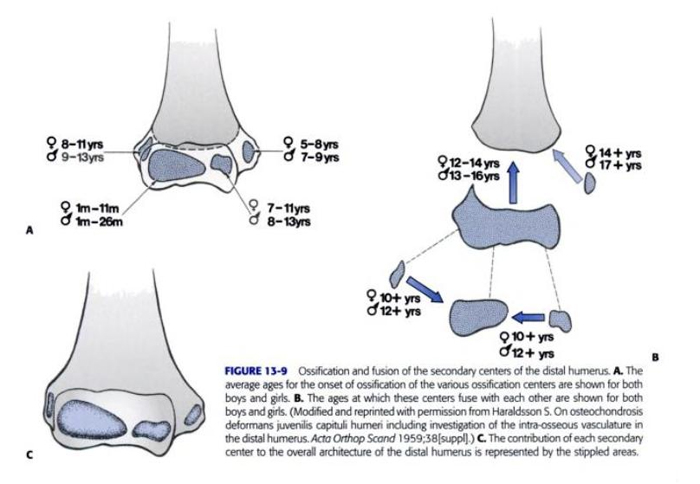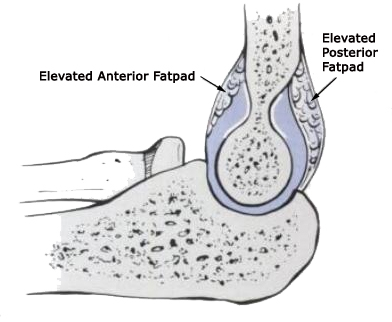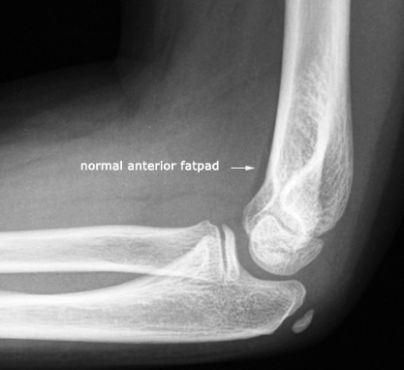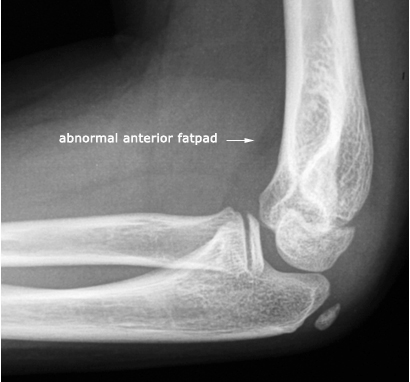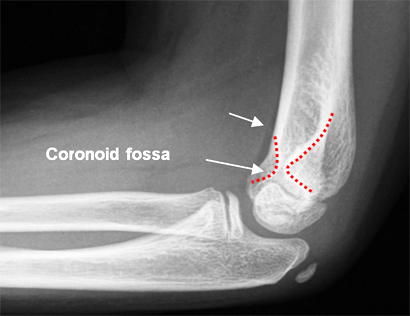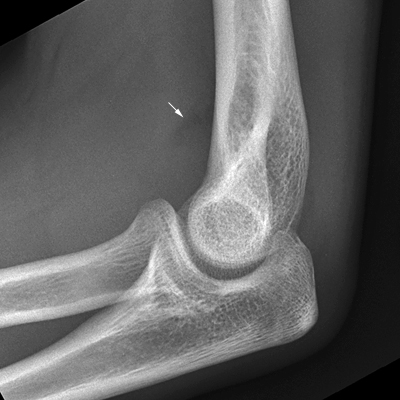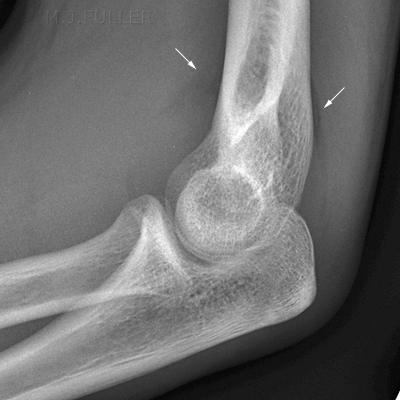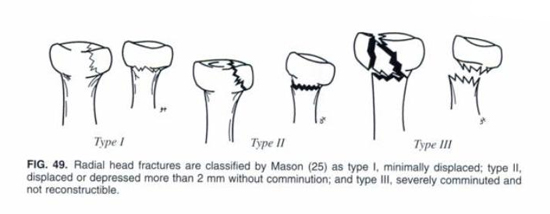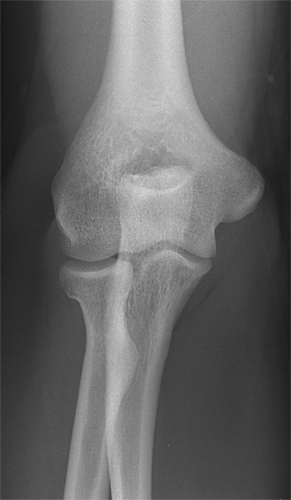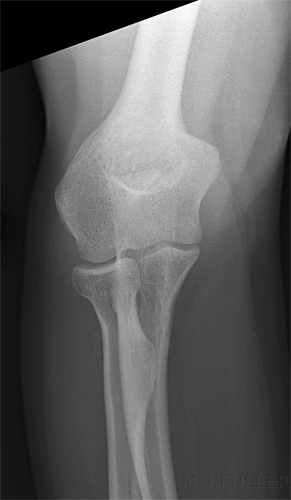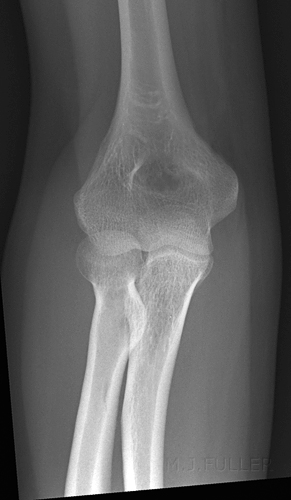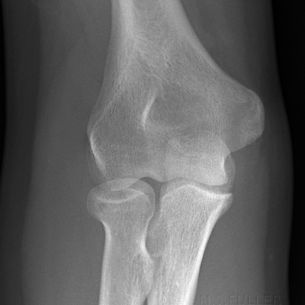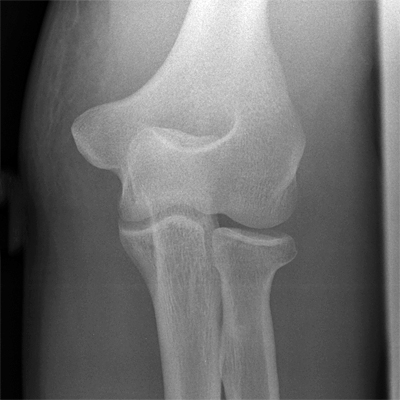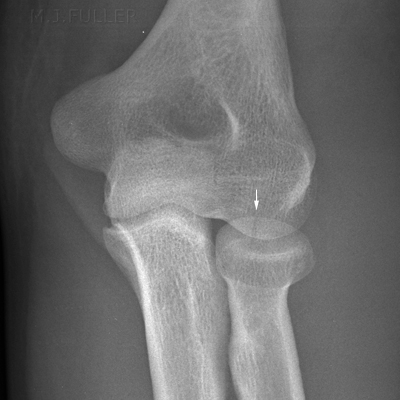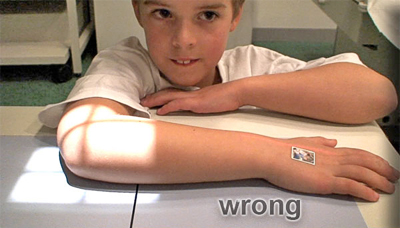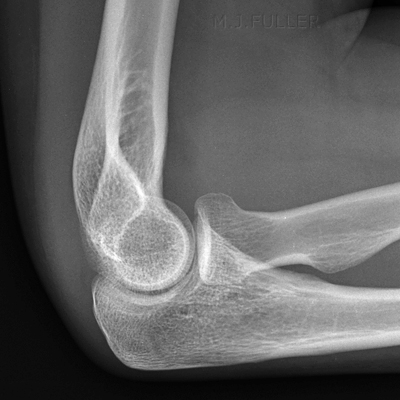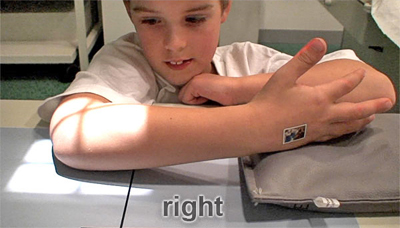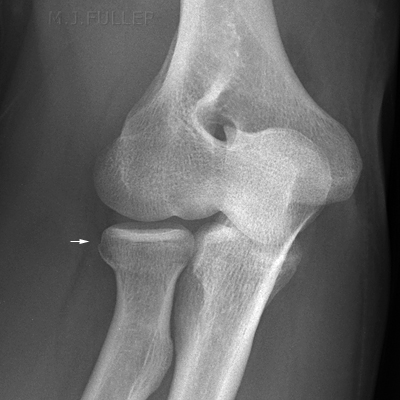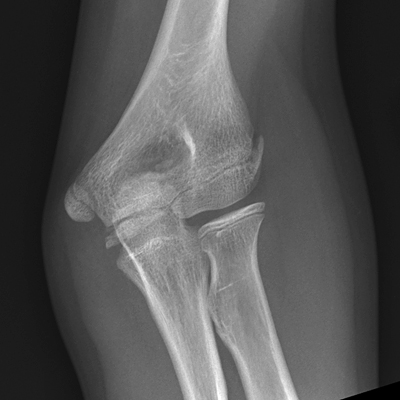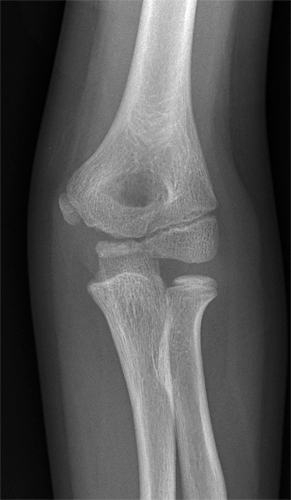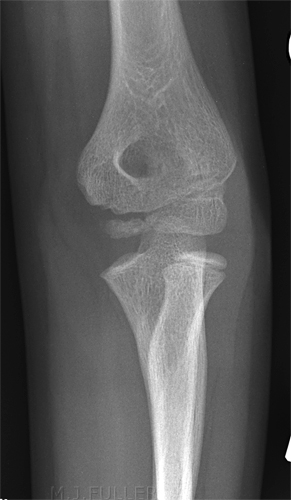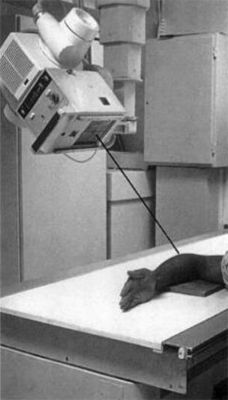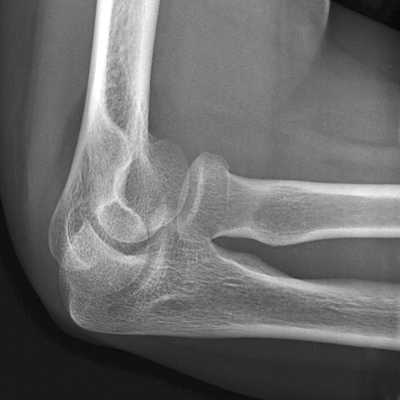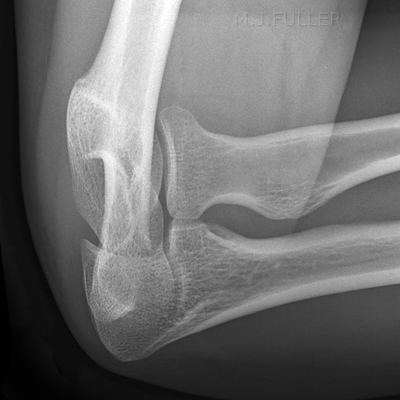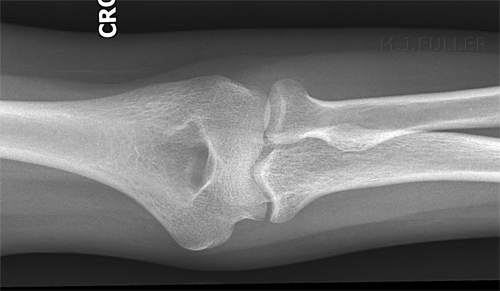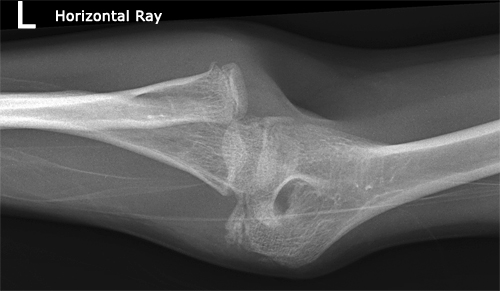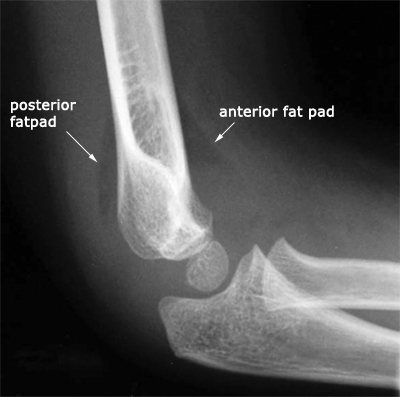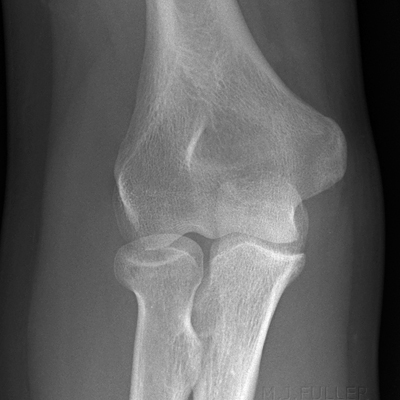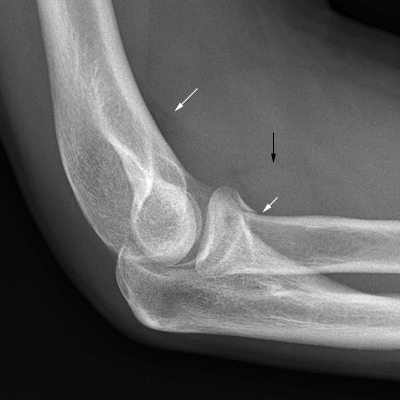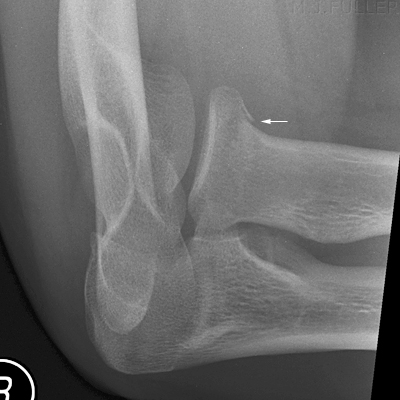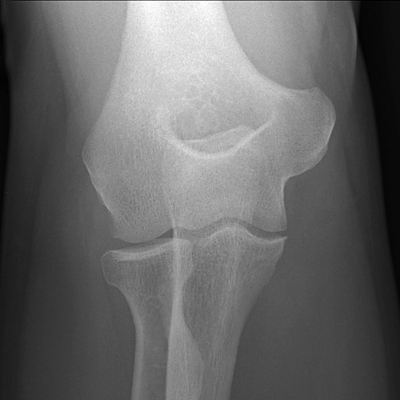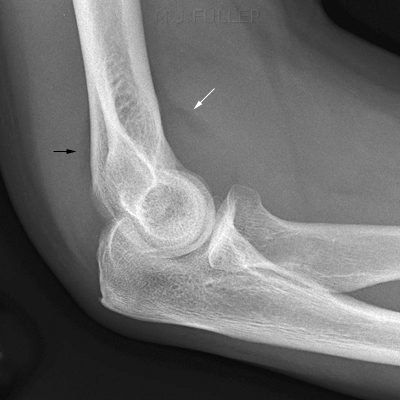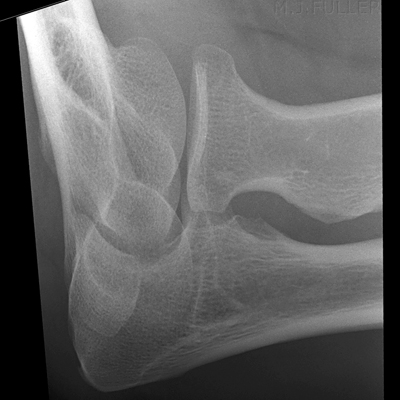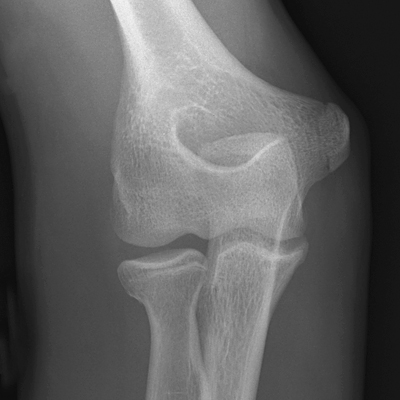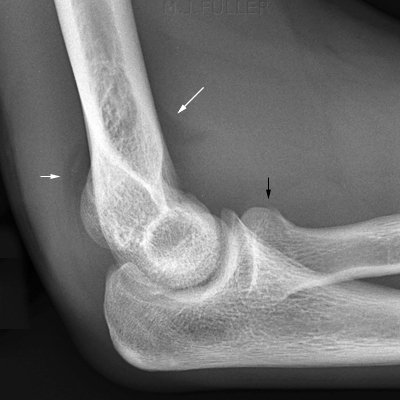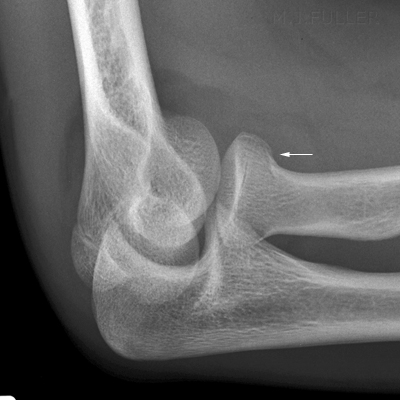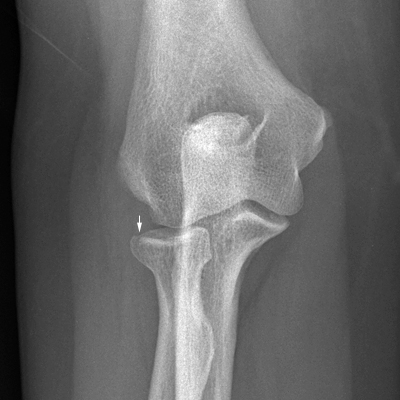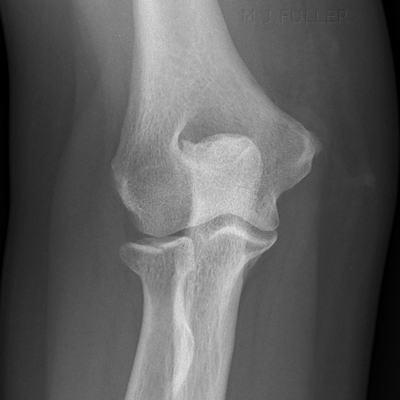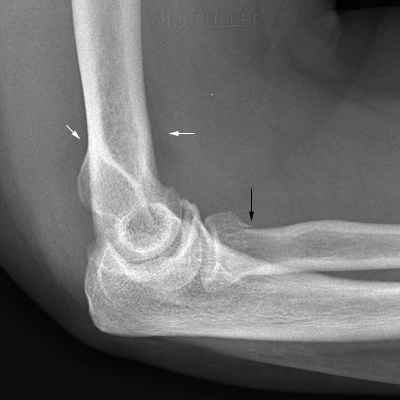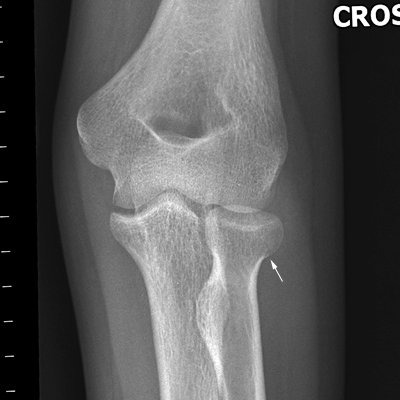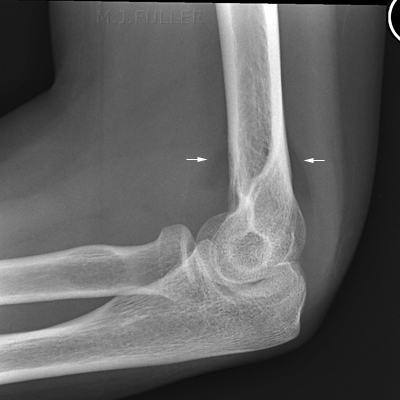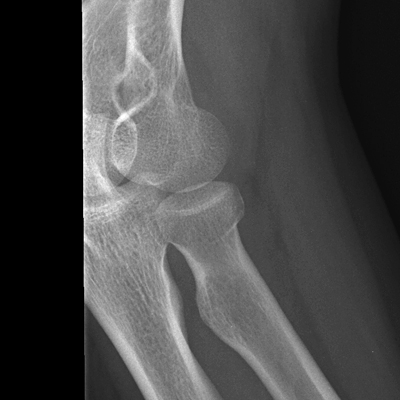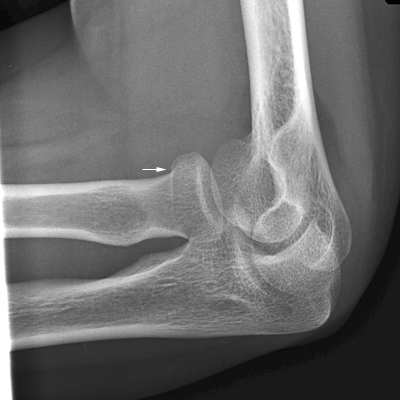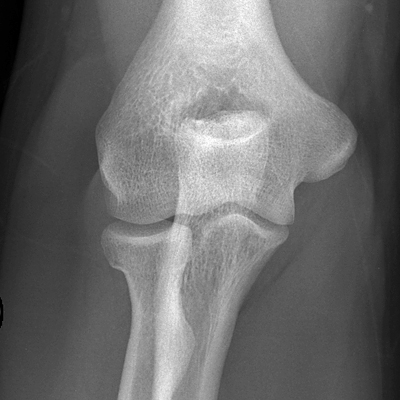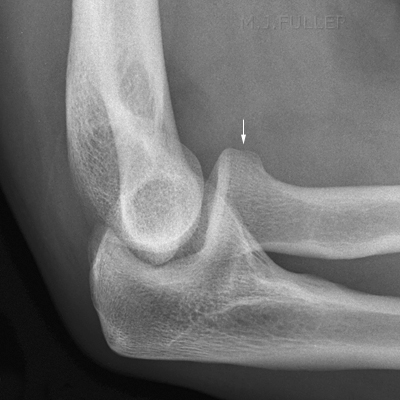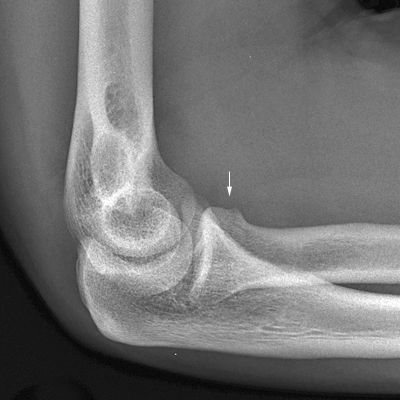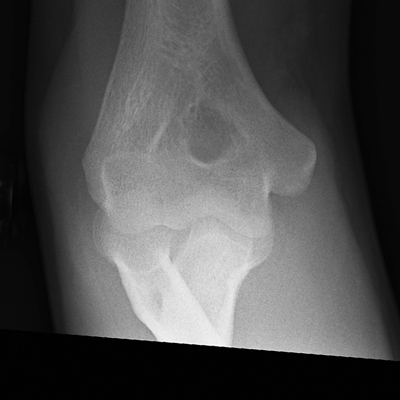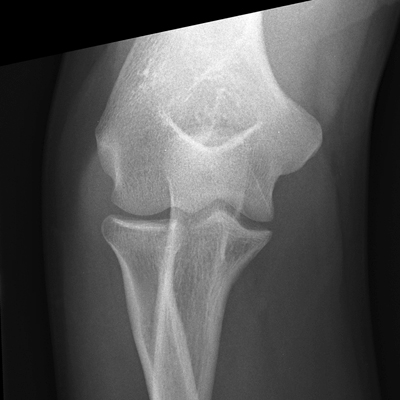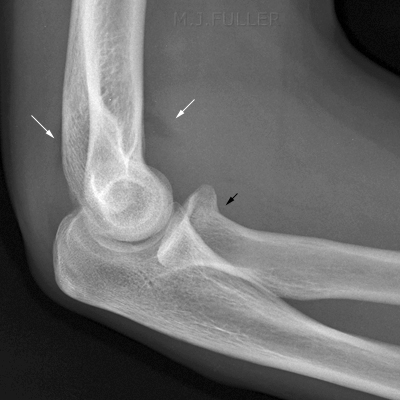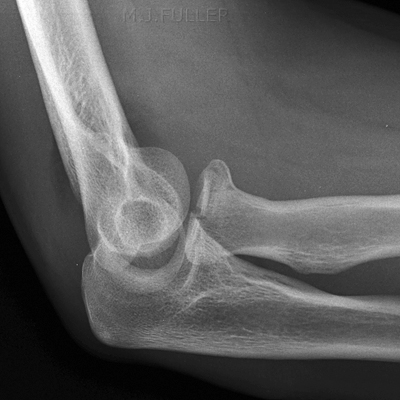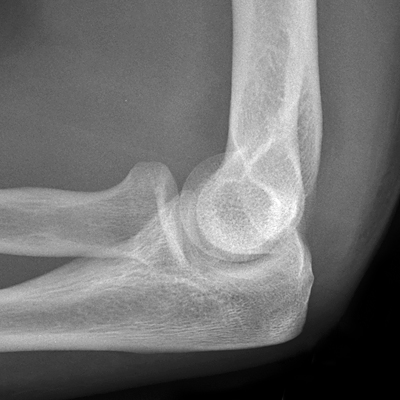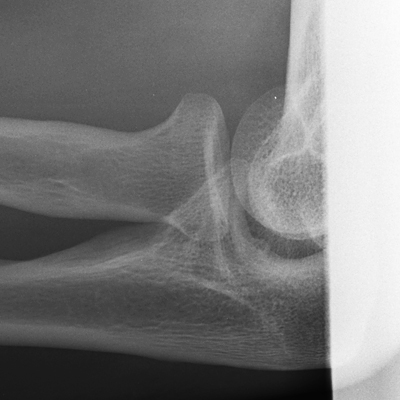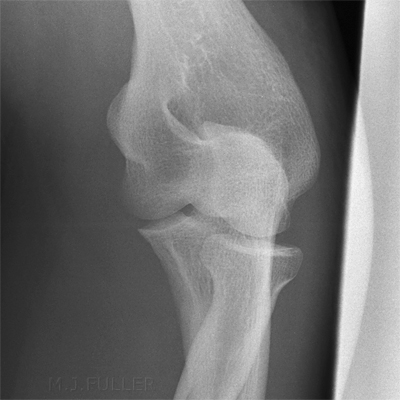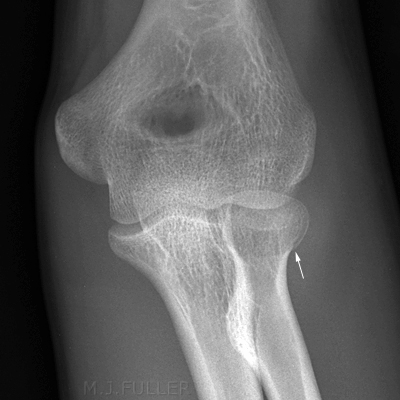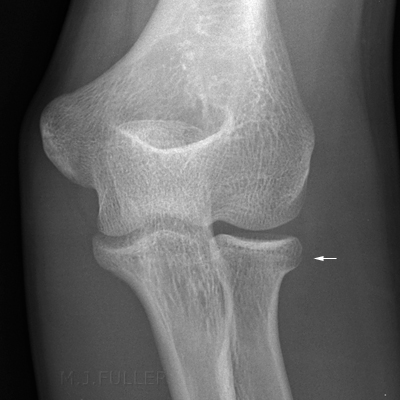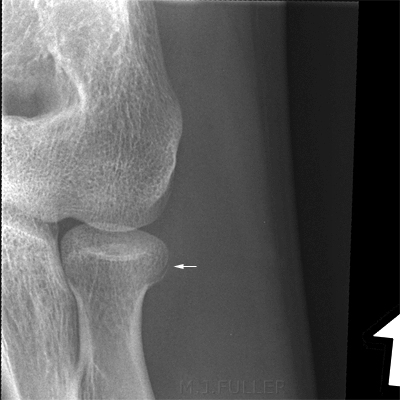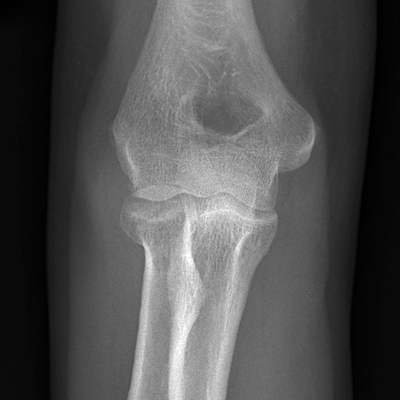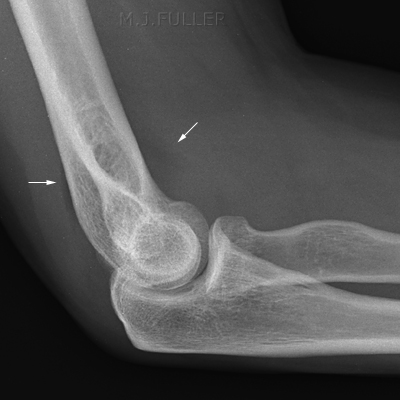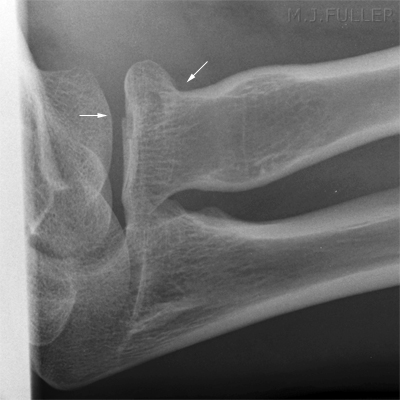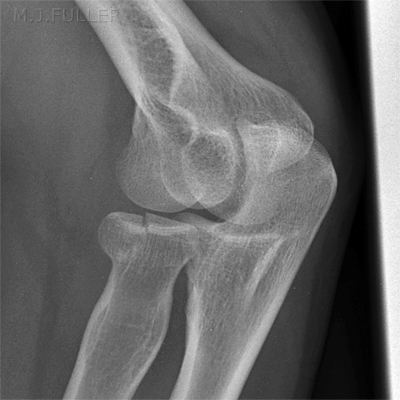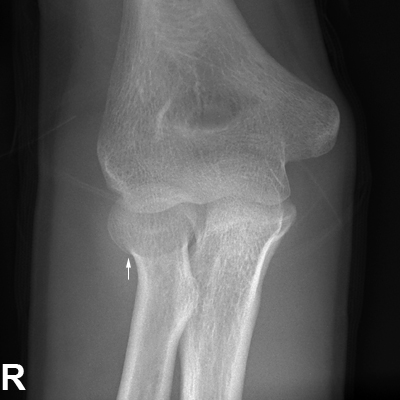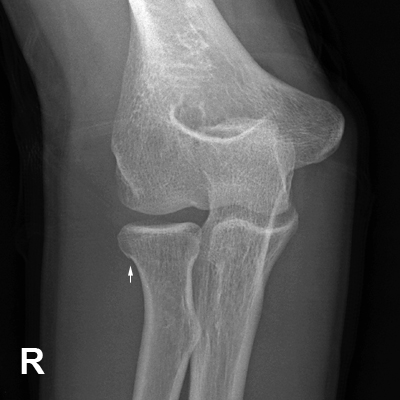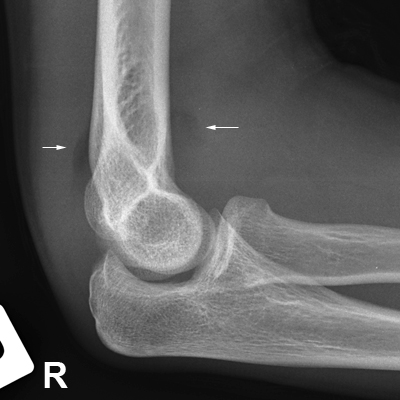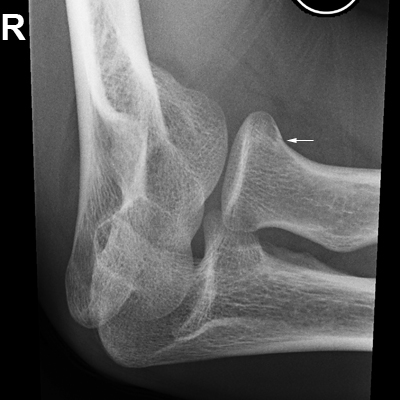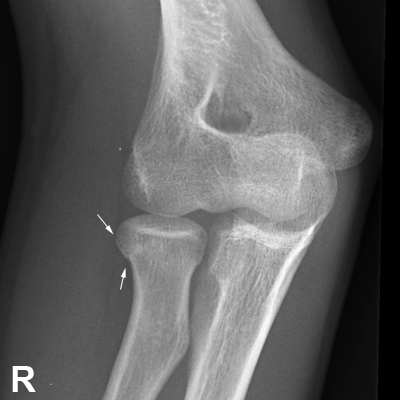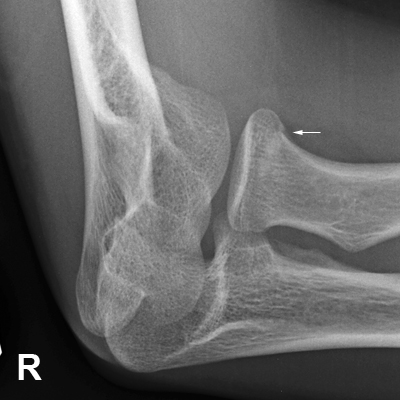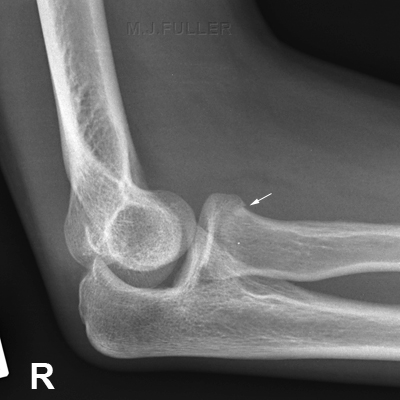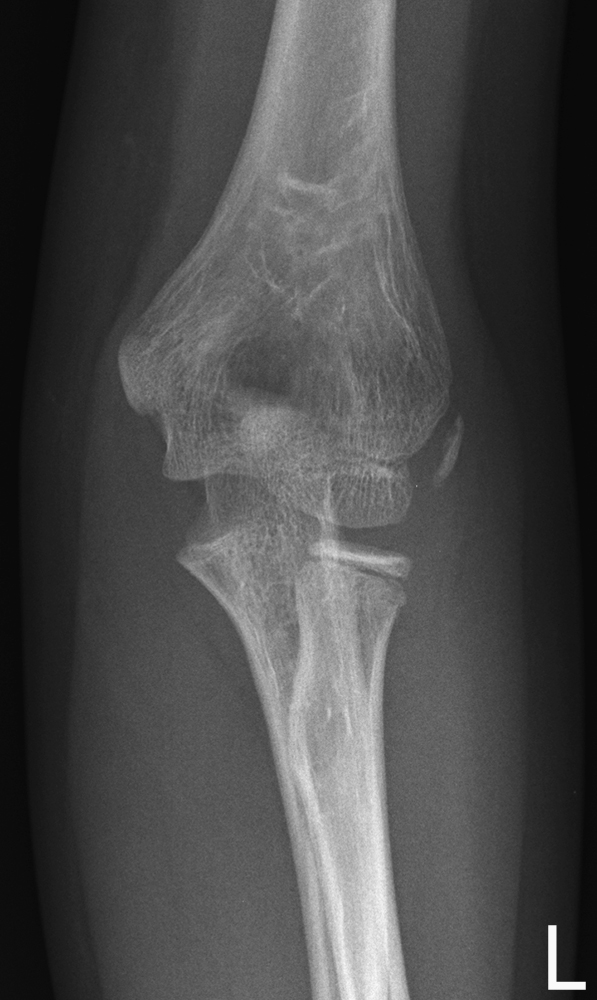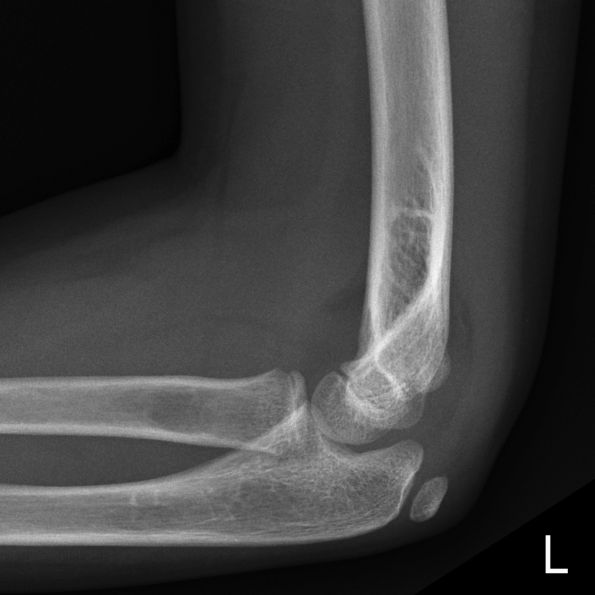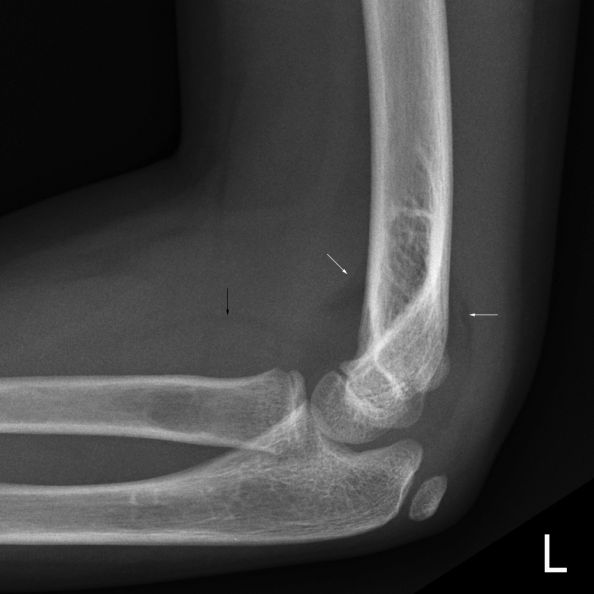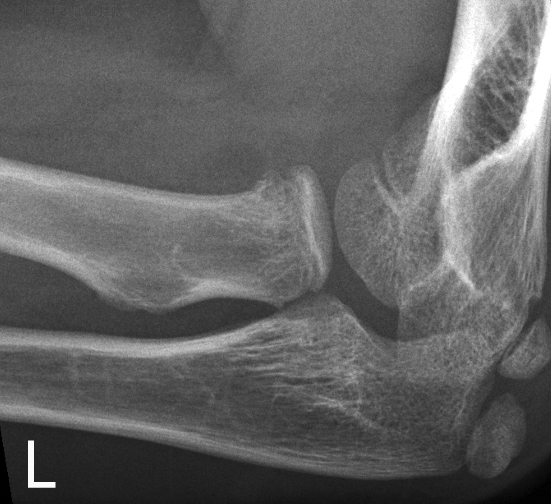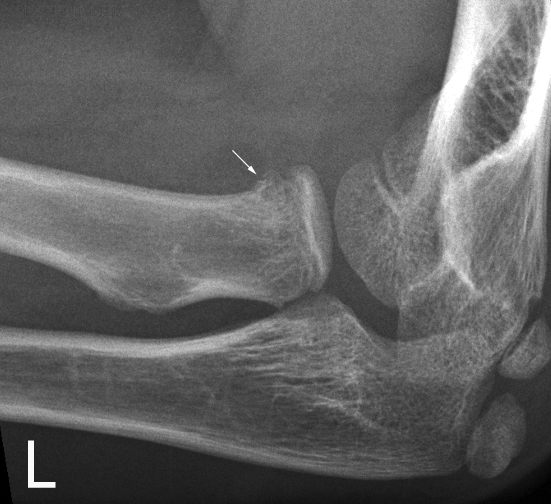Imaging Radial Head Fractures
Radial head and/or neck fracture is a commonly associated with a fall onto an outstretched hand in adults. This page considers radial head radiographic technique and pathological appearances.
Anatomy
Ossification
The paediatric elbow can present a confusing array of ossifications. The ossification centres generally ossify in the order shown (left).
A useful mnemonic for remembering the order of the ossification centres is the CRITOL rule
It is noteworthy that the ossification centres of the elbow do not always follow this order of ossification.Capitellum
Radial head
Internal (medial epicondyle)
Trochlea
Olecranon
Lateral epicondyle
<a class="external" href="http://books.google.com.au/books?id=6AXkE4y1678C&pg=PA509&lpg=PA509&dq=radial+head+fractures+incidence+in+adults&source=bl&ots=JRFuoZ23Kh&sig=r6wMfpmEAfwn6_ySqvaTdogcJVk&hl=en&ei=u_FHSvmRIIfU7AOqkZnoAw&sa=X&oi=book_result&ct=result&resnum=9" rel="nofollow" target="_blank">Charles A. Rockwood, Kaye E. Wilkins, James H. Beaty, James R. Kasser
Rockwood and Wilkins' fractures in children
Lippincott Williams & Wilkins, 2006</a>It can also be helpful in distinguishing fractures from normal ossification centres to be aware of the ages of appearance and fusion of the elbow epiphyses and apophyses.
Elbow Joint Effusion
<a class="external" href="http://books.google.com.au/books?id=6AXkE4y1678C&pg=PA509&lpg=PA509&dq=radial+head+fractures+incidence+in+adults&source=bl&ots=JRFuoZ23Kh&sig=r6wMfpmEAfwn6_ySqvaTdogcJVk&hl=en&ei=u_FHSvmRIIfU7AOqkZnoAw&sa=X&oi=book_result&ct=result&resnum=9" rel="nofollow" target="_blank">Charles A. Rockwood, Kaye E. Wilkins, James H. Beaty, James R. Kasser</a>
<a class="external" href="http://books.google.com.au/books?id=6AXkE4y1678C&pg=PA509&lpg=PA509&dq=radial+head+fractures+incidence+in+adults&source=bl&ots=JRFuoZ23Kh&sig=r6wMfpmEAfwn6_ySqvaTdogcJVk&hl=en&ei=u_FHSvmRIIfU7AOqkZnoAw&sa=X&oi=book_result&ct=result&resnum=9" rel="nofollow" target="_blank">Rockwood and Wilkins' fractures in children</a>
<a class="external" href="http://books.google.com.au/books?id=6AXkE4y1678C&pg=PA509&lpg=PA509&dq=radial+head+fractures+incidence+in+adults&source=bl&ots=JRFuoZ23Kh&sig=r6wMfpmEAfwn6_ySqvaTdogcJVk&hl=en&ei=u_FHSvmRIIfU7AOqkZnoAw&sa=X&oi=book_result&ct=result&resnum=9" rel="nofollow" target="_blank">Lippincott Williams & Wilkins, 2006</a>The elbow joint is a synovial joint. When an elbow injury occurs and there is an intra-articular involvement, there can be an associated elbow effusion. As the elbow joint distends with fluid, the adjacent soft tissues can be displaced. The anterior and posterior fat pads are of particular interest to radiographers because they can provide a valuable indicator of intra-articular injury when the elbow fat pads are displaced by an elbow joint effusion. Importantly, evidence of an elbow joint effusion on elbow plain film images does not indicate a definite elbow fracture- it does indicate an elbow joint injury. The anterior elbow fat pad can often be seen in a normal lateral elbow as a stripe of radiolucency parallel to the anterior cortex of the distal humerus. A visible anterior fat pad can be a normal finding- a visible posterior fatpad is not a normal finding.
<a class="external" href="http://books.google.com.au/books?id=6AXkE4y1678C&pg=PA509&lpg=PA509&dq=radial+head+fractures+incidence+in+adults&source=bl&ots=JRFuoZ23Kh&sig=r6wMfpmEAfwn6_ySqvaTdogcJVk&hl=en&ei=u_FHSvmRIIfU7AOqkZnoAw&sa=X&oi=book_result&ct=result&resnum=9" rel="nofollow" target="_blank">Charles A. Rockwood, Kaye E. Wilkins, James H. Beaty, James R. Kasser</a>
<a class="external" href="http://books.google.com.au/books?id=6AXkE4y1678C&pg=PA509&lpg=PA509&dq=radial+head+fractures+incidence+in+adults&source=bl&ots=JRFuoZ23Kh&sig=r6wMfpmEAfwn6_ySqvaTdogcJVk&hl=en&ei=u_FHSvmRIIfU7AOqkZnoAw&sa=X&oi=book_result&ct=result&resnum=9" rel="nofollow" target="_blank">Rockwood and Wilkins' fractures in children</a>
<a class="external" href="http://books.google.com.au/books?id=6AXkE4y1678C&pg=PA509&lpg=PA509&dq=radial+head+fractures+incidence+in+adults&source=bl&ots=JRFuoZ23Kh&sig=r6wMfpmEAfwn6_ySqvaTdogcJVk&hl=en&ei=u_FHSvmRIIfU7AOqkZnoAw&sa=X&oi=book_result&ct=result&resnum=9" rel="nofollow" target="_blank">Lippincott Williams & Wilkins, 2006</a>
In the presence of an elbow effusion, the fatpads can be displaced in an appearance that is commonly referred to as a sail sign. When you see a sail sign on a lateral elbow image, consider carefully whether you have adequately demonstrated a related fracture, and if not, whether supplementary views would be worthwhile to determine if a fracture exists. Note also a subtle posterior fatpad sign (left)- this is subtle but important in that it suggests a likelihood of fracture at about the 90% level.The distal humerus has two fossae- the coronoid fossa accommodates the coronoid process of the ulna on elbow flexion and the olecranon fossa accommodates the olecranon process of the ulna on elbow extension. The coronoid fossa is a shallower fossa than the olecranon fossa- this is why the anterior fat pad can appear as a normal elbow feature and also explains why an anterior fat pad sign can appear without the posterior fat pad sign. i.e. it takes a larger elbow effusion to displace the posterior fat pad out of the deeper olecranon fossa than the anterior fat pad out of the shallower coronoid fossa.
Mason's Classification of Radial Head Fractures
Radiographic Technique
AP Elbow
Lateral Elbow
<a class="external" href="http://www.radiologyassistant.nl/en/4214416a75d87" rel="nofollow" target="_blank">www.radiologyassistant.nl/en/4214416a75d87</a>
<a class="external" href="http://www.radiologyassistant.nl/en/4214416a75d87" rel="nofollow" target="_blank">www.radiologyassistant.nl/en/4214416a75d87</a>
Oblique Elbow
Reverse Oblique Elbow
The radial head, capitellum view
<a class="external" href="http://books.google.com.au/books?id=iJZyb0s7dhgC&pg=RA3-PA341&lpg=RA3-PA341&dq=elbow+radiography&source=bl&ots=VlMjhi5fob&sig=yGvshuYLxyz9yaOj4z-51_NBV6w&hl=en&ei=A3VJSon3LZWVkAWX_sjvCQ&sa=X&oi=book_result&ct=result&resnum=5" rel="nofollow" target="_blank">The Radiology of Emergency Medicine, </a>
<a class="external" href="http://books.google.com.au/books?id=iJZyb0s7dhgC&pg=RA3-PA341&lpg=RA3-PA341&dq=elbow+radiography&source=bl&ots=VlMjhi5fob&sig=yGvshuYLxyz9yaOj4z-51_NBV6w&hl=en&ei=A3VJSon3LZWVkAWX_sjvCQ&sa=X&oi=book_result&ct=result&resnum=5" rel="nofollow" target="_blank">4th Edition John H. Harris, Jr and William H. Harris (Eds), </a>
<a class="external" href="http://books.google.com.au/books?id=iJZyb0s7dhgC&pg=RA3-PA341&lpg=RA3-PA341&dq=elbow+radiography&source=bl&ots=VlMjhi5fob&sig=yGvshuYLxyz9yaOj4z-51_NBV6w&hl=en&ei=A3VJSon3LZWVkAWX_sjvCQ&sa=X&oi=book_result&ct=result&resnum=5" rel="nofollow" target="_blank">Lippincott, Williams & Wilkins, Philadelphia, 2000</a>The radial head view is often the only projection that demonstrates a subtle radial head fracture. To perform this view correctly the following are noteworthy
- the elbow should be in a true lateral position. This is often impossible in a patient with a radial head fracture. In particular, rotation of the hand into a lateral position may be difficult.
- a 45 degree tube angle will produce an elongated view of the anatomy but will be more likely to project the radial head clear of the ulna
- learn where the radial head is positioned in this view and collimate the X-ray beam to include the anatomy of interest only.
further reading
Greenspan A, Norman A. The radial head, capitellum view: useful technique in elbow trauma. AJR Am J Roentgenol. 1982 Jun;138(6):1186-8.
Some radiographers prefer a 30 degree tube angle for radial head views. With a 45 degree tube angulation and the elbow in a true lateral position you should produce an image of the radial head as shown above. Note that the radial head is largely projected clear of the ulna.
Image Interpretation
Horizontal Ray Elbow Radiography
The Fat Pad sign
Case Studies
Case 1
This 20 year old male presented to the Emergency Department following a fall from his skateboard. He had pain in his right elbow and a limited range of movement. He was referred for elbow radiography.
Comment
The radial head fracture is most convincingly demonstrated on the 45 degree radial head view. This is often the case with radial head fractures.
Case 2
This 38 year old male presented to the Emergency Department following a fall onto an outstretched hand . He had pain in his right elbow and a limited range of movement. He was referred for elbow radiography.
Comment
It is possible that this patient has not sustained any bony injury. It is equally possible that the patient has an undisplaced radial head fracture that has not been demonstrated on this examination.
Case 3
This 15 year old male presented to the Emergency Department following a fall onto an outstretched hand after falling off his pushbike. He had pain in his right elbow and a decreased range of movement. He was referred for elbow radiography.
Case 4
This 56 year old lady presented to the Emergency Department following a fall from steps onto an outstretched hand . She had pain in her right elbow and a decreased range of movement. She was referred for elbow radiography.
Case 5
This 17 year old girl presented to the Emergency Department after falling from a car bonnet . She had pain in her left elbow and a decreased range of movement. She was referred for elbow radiography.
Comment
Subtle radial head fractures may only be demonstrated conclusively on the 45 degree radial head view image.
Case 6
This 30 year old man presented to the Emergency Department after falling during a game of soccer . He had pain and swelling in his right elbow and a decreased range of movement. He was referred for elbow radiography.
Case 7
This 19 year old male presented to the Emergency Department after falling off his pushbike. He had pain and a decreased range of movement in his right elbow. He was unable to pronate and supinate his right hand. He was referred for elbow radiography.
Comment
The improved demonstration of the radial head fracture on the dedicated radial head view illustrates the value of this projection
Case 8
This 23 year old male presented to the Emergency Department after falling off his skateboard. He had an extremely swollen and painful left elbow. He was referred for elbow radiography.
This is also an AP elbow view image with the elbow in partial flexion and the forearm in contact with the image receptor. There are several lucent lines through the radial head suggesting a comminuted fracture. This is an AP elbow view image with the elbow in partial flexion. The positioning is biased to demonstrate the humerus. (see option 3 above)
There is a fracture of the radial head- possibly comminuted in a peace sign configuration (also called a Mercedes sign)<a class="external" href="http://eorif.com/Elbowforearm/Radial+Head+fx.html" rel="nofollow" target="_blank">
</a>
<a class="external" href="http://eorif.com/Elbowforearm/Radial+Head+fx.html" rel="nofollow" target="_blank">http://eorif.com/Elbowforearm/Radial%20Head%20fx.html</a>The lateral elbow view image demonstrates anterior and posterior fatpad signs- they are not sharply delineated but, nevertheless, are strongly suggested. This is a 30 degree radial head view image. No displaced fracture is convincingly demonstrated. This is a reverse oblique view image. A vertical fracture line through the radial head is demonstrated.
Comment
This case demonstrates the value of the AP elbow view with the patient's elbow in partial flexion and the humerus in contact with the image receptor. This view produces a partially axial projection of the radial head which demonstrated the nature of this fracture well.
Case 9
This 16 year old girl presented to the Emergency Department after falling onto her left arm. She had a painful left elbow. She was referred for elbow radiography.
Comment
This case demonstrates the subtlety of some radial head fractures. Undisplaced fractures of the radial head are sometimes impossible to demonstrate on first presentation and may not show until the second, or even third radiographic examination. Note also that subtle differences in the lateral elbow position can improve the demonstration of the elbow fat pads.
Case 10
This 43 year old lady presented to the Emergency Department after falling onto an outstretched hand. She had a painful left elbow which she was unable to extend. She was referred for elbow radiography.
Comment
This case demonstrates the potential value of the external oblique view of the elbow in demonstrating radial head fractures.
Case 11
This 15 year old male presented to the Emergency Department after falling onto his right arm. His elbow was examined and found to be swollen and there was a limited range of movement in the elbow joint. He was referred for right elbow radiography.
Comment
This case demonstrates a typical undisplaced radial head fracture. The follow-up imaging of the elbow clearly demonstrates the radial head fracture.
Case 12
Summary
Patients with radial head fractures will occasionally provide a challenge for the trauma radiographer. Achieving good quality imaging in a patient who is in considerable pain can test the innovative/adaptive skills of junior and seasoned radiographers alike. Radial head fractures can be subtle requiring a balanced consideration of the mechanism of injury and subtle soft tissue signs when deciding which patients to pursue with supplementary views and which to save from further irradiation. Some radial head fractures will only be demonstrated radiographically on second or even third presentations.
... back to the Wikiradiography home page
...back to the Applied Radiography home page
